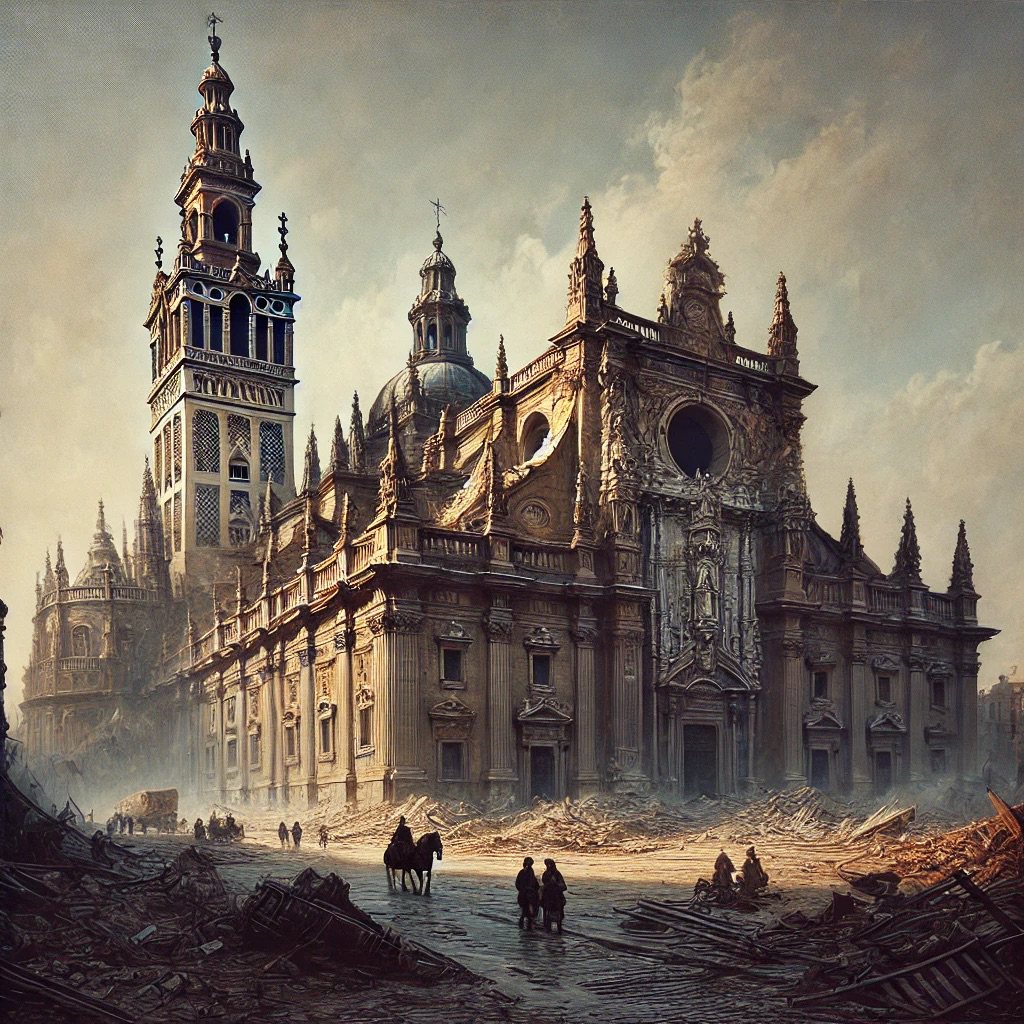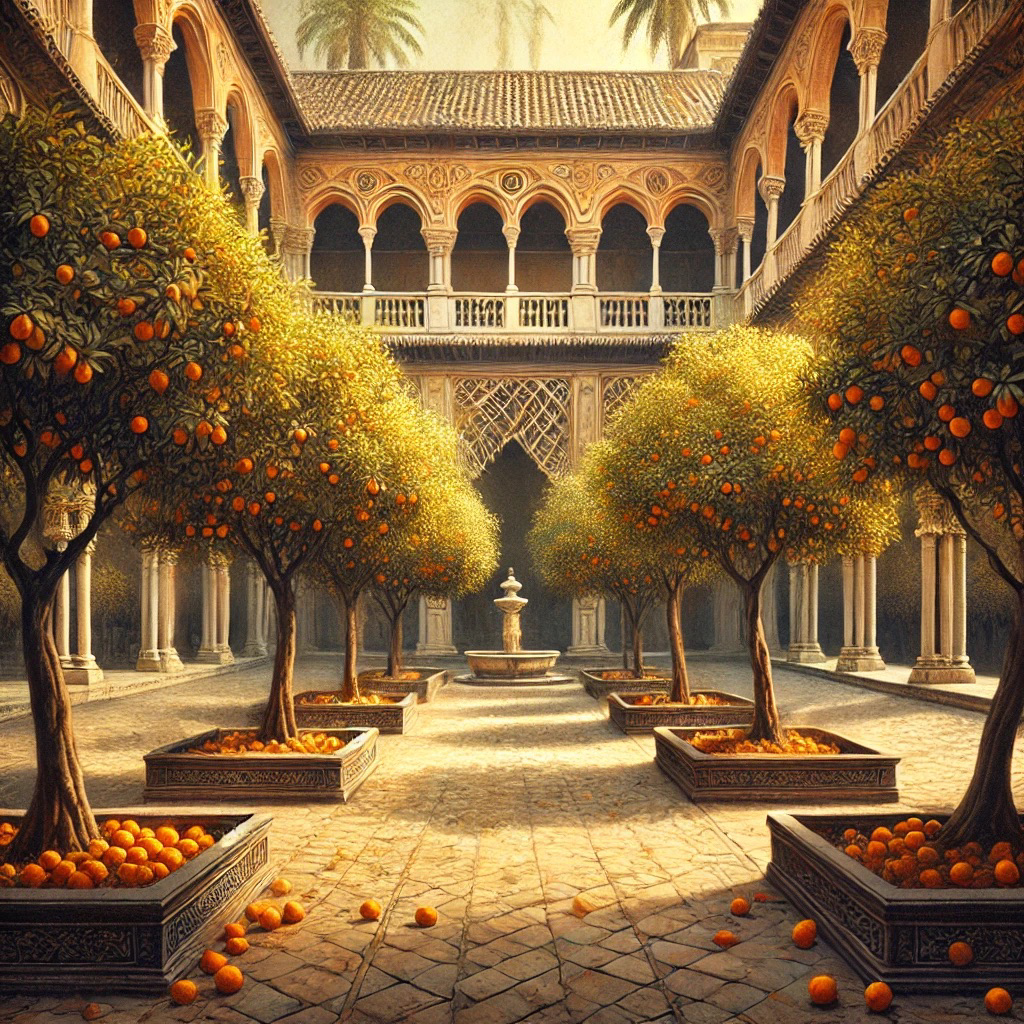A complete guide to a major part of Seville history, including La Giralda, Christopher Columbus, royal weddings and the Spanish Inquisition.
In the heart of Seville stands a cathedral that defies simple description. Built on the ruins of a mosque, this massive Gothic masterpiece reflects the ambitions of a city eager to cement its place on the world stage.
Origins and Construction of Seville Cathedral
Seville in the late 14th century: a bustling hub of commerce and culture, still echoing with the influence of its Moorish past. The city is vibrant, filled with the sounds of merchants, artisans and the ever-present calls to prayer from the towering minaret of the Great Mosque of Seville, built during the Almohad dynasty, which dominates the skyline.
Yet, beneath the surface, there’s a growing restlessness among the Christian rulers. They dream of an awe-inspiring structure that would not only dwarf the mosque but would also stand as a testament to the power of their piety.
In 1401, that dream begins to take shape. The city leaders, fueled by both ambition and a desire to solidify Christian dominance, gather to discuss the construction of a new cathedral. During one meeting, a church elder boldly declares, “Let us build a church so beautiful and so grand that those who see it finished will think we are mad.”
The decision was made: Seville would build the largest cathedral in the world, a Gothic masterpiece that would leave an indelible mark on history.
The Transition From Mosque to Cathedral
But before this vision could be realized, there was the matter of the mosque. Built in the late 12th century, the Great Mosque was a symbol of Muslim rule in Seville. With its elegant arches, intricate tilework and towering minaret, it was a marvel of Islamic architecture.
In the wake of the Reconquista, when the Christian states recaptured territory ruled by the Muslim Moors, the mosque was consecrated as a church. For over a century, it served as the city’s cathedral — but it was clear to the Christian rulers that something more magnificent was needed.
The decision was made to demolish most of the mosque, though the minaret and the Patio de los Naranjos (Courtyard of the Orange Trees) were spared, becoming integral parts of the new cathedral. This wasn’t just a practical decision but a symbolic one, blending the old with the new, and honoring the complex cultural history of Seville.
It certainly wasn’t the first time such appropriation took place. Spain in particular had a tendency to transition from mosques to churches, reflecting the shifts in power over the centuries. La Mezquita in Córdoba, with its blend of Islamic and Christian architecture, is not only one of the most striking but also the earliest example of such a transformation.
Architectural Challenges and Triumphs
As construction began, the scale of the project quickly became apparent. The builders faced immense challenges, not least of which was the sheer size of the cathedral.
At its peak, the construction site buzzed with hundreds of workers — stone masons, carpenters, artisans — all toiling to bring the ambitious vision to life. The air was thick with dust and the sound of chisels striking stone, as massive blocks of limestone were shaped into the soaring arches and ribbed vaults that define the Gothic style.
Key Figures in Seville Cathedral’s Creation
Behind this monumental effort were some of the most brilliant minds of the time. Master architects like Charles Galter and Alonso Martínez, among others, brought their expertise to the project. Galter, known for his work on other Gothic cathedrals in Spain, was particularly instrumental in the design of the soaring nave and the intricate stonework that adorns the exterior.
The artisans who carved the statues, the stonemasons who shaped each block, and the laborers who worked tirelessly day after day were all part of this grand endeavor. Their collective effort created something far greater than the sum of its parts.
The Grand Unveiling and Seville Cathedral’s Legacy
The construction of Seville Cathedral, or Catedral de Sevilla, took over a century to complete, with work continuing long after the original architects had passed away. But when the cathedral was finally finished in 1528, it was clear that their bold vision had been realized. When you visit the Seville Cathedral, you can only marvel at its scale, its beauty — and its audacity.
To the average Sevillano, its sheer size would have been overwhelming, a towering monument that seemed to reach up to Heaven itself. Its intricate details — gargoyles, statues of saints and other elaborate carvings — invite closer inspection, revealing new wonders at every turn.
La Giralda: From Minaret to Bell Tower
The mosque that once stood here was the pride of the Islamic world, and its minaret — the future Giralda — was a marvel of engineering. The city’s Muslim residents would pause in their daily routines as the call to prayer echoed across the rooftops. The minaret was a spiritual beacon, guiding the faithful and asserting the dominance of Islam in the region.
It would remain a spiritual beacon — just for those of the Catholic faith now. In the 16th century, a Renaissance-style belfry was added to the top, transforming the minaret into a bell tower.
At the very top of the tower stands El Giraldillo, a bronze statue that functions as a weathervane. This figure, representing Faith, stands with one foot firmly planted on the tower, while the other seems to step into the air, as if ready to take flight.
Because the statue could turn with the wind, the tower itself came to be known as La Giralda, meaning “The One That Turns” or “The Spinner.”
La Giralda also plays a part in the eerie legends of Seville Cathedral, when a scorned bride-to-be cursed the bell tower and all those who dare to be unfaithful in its vicinity.
A Stage for History: Seville Cathedral’s Role in Historic Events
Royal Weddings: The Joining of Crowns and Countries
It’s October 18, 1526. The cathedral is adorned with tapestries, lit by the flickering flames of hundreds of candles. The air is filled with anticipation, as the people of Seville gather to witness the wedding of the century: the marriage of Holy Roman Emperor Charles V and Isabella of Portugal. The union of these two powerful figures promises to shape the future of Europe.
The bride and groom exchange vows beneath the towering altar, surrounded by the highest nobility of Spain and Portugal. The grandeur of the ceremony reflects the power and wealth of the Spanish empire at its height.
But this wasn’t the only royal wedding held in Seville Cathedral. Over the centuries, the cathedral has hosted numerous royal ceremonies, each one adding to its legacy as a place where the personal and the political intersect, where the fate of nations has often been decided at the altar.
The cathedral hosted the royal weddings of Philip II and Elisabeth of Valois in 1559; Philip III and Margaret of Austria in 1599; and Philip IV and Elisabeth of France in 1615, each marking significant political alliances in European history.
The Spanish Inquisition: A Dark Chapter
However, not all of the cathedral’s historical events were moments of celebration. The Spanish Inquisition, a dark chapter in the country’s history, also left its dubious mark on Seville Cathedral. During this time, the cathedral served as a setting for the public sentencing of those accused of heresy, events known as autos-da-fé (Portuguese for “acts of faith” — a euphemism if there ever was one).
Picture it: The cathedral, normally a place of worship and reflection, is transformed into a courtroom. The accused, dressed in penitential robes, stand before the altar, their fates hanging in the balance. The atmosphere is tense, as the Inquisitors pass judgment in the name of religious purity.
The results were horrific: Over 700 people were burned at the stake, and more than 5,000 others faced imprisonment, forced penance and the stripping away of their social status.
These grim proceedings unfolded in public spectacles where fear and fanaticism reigned supreme, forever marking Seville as a place where religious zealotry took its darkest form.
A Witness to the New World: Columbus and the Age of Exploration
Seville Cathedral also played a significant role during the Age of Exploration, when Spain was at the forefront of colonizing the Americas. The cathedral was the site of numerous ceremonies celebrating the successes of explorers like Columbus, whose voyages expanded the Spanish empire and brought immense wealth and influence to the crown.
One of the most poignant moments in this history occurred in 1502, when Columbus, known locally as Cristóbal Colón, then an old man, attended a mass at Seville Cathedral before departing on his fourth and final voyage to the Americas.
Standing in the very same spot, you can almost imagine Columbus, weary yet resolute, contemplating the journey ahead. The cathedral, with its vastness and grandeur, must have seemed like a fitting place to seek divine favor before embarking on such a perilous and uncertain journey.
Semana Santa in Seville
During Semana Santa, or Holy Week, in Seville, the streets fill with processions led by hooded nazarenos from various brotherhoods. Dressed in long robes and creepy pointed hoods known as capirotes that cover their faces, they carry candles or crosses in solemn silence. The color of their robes — black, purple, white, red or green — reflects the symbolism of their brotherhood. Massive, ornate floats (pasos) depicting scenes from the Passion of Christ or the sorrowful Virgin Mary are carried through the streets, held up by hidden penitents called costaleros. The air is filled with the sounds of traditional music or the haunting cry of a saeta, a flamenco-style song, creating a deeply spiritual atmosphere.
The processions begin and end at the cathedral, reinforcing its status as the spiritual heart of Seville.
A Beacon of Resilience: Surviving Earthquakes and Wars
Seville Cathedral’s history is also a story of resilience. Over the centuries, it has withstood natural disasters and human conflicts that have threatened its very existence. One of the most significant of these was the 1755 Lisbon earthquake, which caused widespread devastation across Portugal and Spain. The cathedral suffered considerable damage, with sections of its roof collapsing and the Giralda tower sustaining cracks.
Yet, the cathedral was repaired and restored, standing as a testament to the city’s determination to preserve its cultural treasures.
Then, during the Spanish Civil War, the cathedral was once again at risk. The conflict saw many religious buildings across Spain looted or destroyed — but Seville Cathedral was spared, thanks in part to the efforts of local citizens who recognized its importance to their heritage.
A UNESCO World Heritage Site: Acknowledging Its Global Importance
In 1987, Seville Cathedral was designated as a UNESCO World Heritage Site, alongside the Alcázar palace complex and the General Archive of the Indies. This prestigious recognition is a testament to the cathedral’s global significance.
As a UNESCO site, Seville Cathedral is recognized for its architectural splendor, its historical importance and its role as a center of cultural heritage. The designation also brings with it a commitment to preservation, ensuring that future generations will be able to experience the cathedral’s beauty and history as we do today. The recognition has helped to elevate the cathedral’s status on the world stage, attracting visitors from every corner of the globe who come to marvel at its grandeur and delve into its rich history.
A Symbol of the City
Today, the cathedral stands as a symbol of the resilience and enduring spirit of Seville, a city that has weathered the storms of history, adapted while honoring its past, and emerged stronger each time. –Wally


































